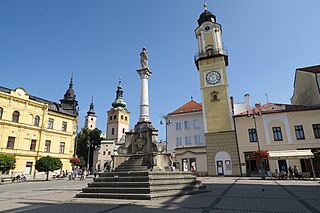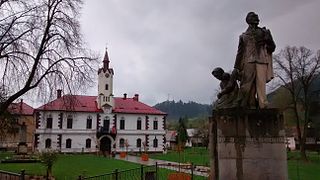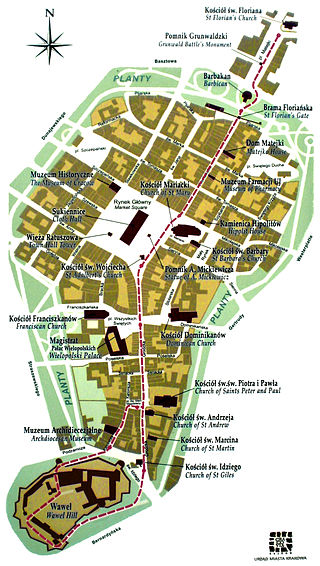
A defensive wall is a fortification usually used to protect a city, town or other settlement from potential aggressors. The walls can range from simple palisades or earthworks to extensive military fortifications such as curtain walls with towers, bastions and gates for access to the city. From ancient to modern times, they were used to enclose settlements. Generally, these are referred to as city walls or town walls, although there were also walls, such as the Great Wall of China, Walls of Benin, Hadrian's Wall, Anastasian Wall, and the Atlantic Wall, which extended far beyond the borders of a city and were used to enclose regions or mark territorial boundaries. In mountainous terrain, defensive walls such as letzis were used in combination with castles to seal valleys from potential attack. Beyond their defensive utility, many walls also had important symbolic functions – representing the status and independence of the communities they embraced.

A city gate is a gate which is, or was, set within a city wall. It is a type of fortified gateway.

Banská Štiavnica is a town in central Slovakia, in the middle of an immense caldera created by the collapse of an ancient volcano. For its size, the caldera is known as the Štiavnica Mountains. Banská Štiavnica has a population of more than 10,000. It is a completely preserved medieval town. Because of their historical value, the town and its surroundings were proclaimed by the UNESCO to be a World Heritage Site on December 11, 1993.

A barbican is a fortified outpost or fortified gateway, such as at an outer defense perimeter of a city or castle, or any tower situated over a gate or bridge which was used for defensive purposes.

Kremnica is a town in central Slovakia. It has around 5,300 inhabitants. The well-preserved medieval town built above important gold mines is the site of the oldest still-working mint in the world.

The Banská Bystrica Region is one of the eight regions of Slovakia. It is the largest of the eight regions by area, and has a lower population density than any other region. The Banská Bystrica Region was established in 1923; its borders were last adjusted in 1996. Banská Bystrica consists of 514 municipalities, 24 of which have town status. Its administrative center is the eponymous town of Banská Bystrica, which is also the region's largest town. Other important towns are Zvolen and Lučenec.

Kraków Old Town is the historic central district of Kraków, Poland. It is one of the most famous old districts in Poland today and was the centre of Poland's political life from 1038 until King Sigismund III Vasa relocated his court to Warsaw in 1596.

The Gothic architecture arrived in Poland in the first half of the 13th century with the arrival of the Dominican and Franciscan orders. The first elements of the new style are evident in the foundation of the Dominican Trinity church in Kraków (1226–1250), built by Bishop Iwo Odrowąż. Rebuilding of the Wrocław Cathedral, started in 1244, was another early manifestation of the Gothic style. The earliest building in Poland built entirely in the Gothic style is the chapel of St. Hedwig in Trzebnica (1268–1269), on the grounds of a Cistercian monastery.

The Main Square of the Old Town of Kraków, Lesser Poland, is the principal urban space located at the center of the city. It dates back to the 13th century, and at 3.79 ha is sometimes called the largest medieval town square in Europe, but Charles Square in Prague is two times larger. The Project for Public Spaces (PPS) lists the square as the best public space in Europe due to its lively street life, and it was a major factor in the inclusion of Kraków as one of the top off-the-beaten-path destinations in the world in 2016.
Tourism in Slovakia offers natural landscapes, mountains, caves, medieval castles and towns, folk architecture, spas and ski resorts.

Ľubietová is a village in central Slovakia. Originally an ancient mining town, it is known for precious minerals.

Nový zámok is a castle in Banská Štiavnica, Slovakia. The castle is located on a hill south of the city center at an altitude of 630m above sealevel, marking the highest point of the city center.

Planty is one of the largest city parks in Kraków, Poland. It encircles the Stare Miasto , where the Medieval city walls used to stand until the early 19th century. The historic Old Town is not to be confused with the Administrative District No. 1 Stare Miasto extending further east.

The Royal Road or Royal Route in Kraków, Poland, begins at the northern end of the medieval Old Town and continues south through the centre of town towards Wawel Hill, where the old royal residence, Wawel Castle, is located. The Royal Road passes some of the most prominent historic landmarks of Poland's royal capital, providing a suitable background to coronation processions and parades, kings' and princes' receptions, foreign envoys and guests of distinction traveling from a far country to their destination at Wawel.

The city of Kraków is divided into 18 administrative districts, each with a degree of autonomy within the municipal government. The Polish name for such a district is dzielnica.

The Third Mongol invasion of Poland was carried out by Talabuga Khan and Nogai Khan in 1287–1288. As in the second invasion, its purpose was to loot Lesser Poland, and to prevent Duke Leszek II the Black from interfering in Hungarian and Ruthenian affairs. The invasion was also part of the hostilities between Poland and Ruthenia; in 1281, the Poles had defeated a Mongol force near Goslicz which had entered Duke Leszek's territory in support of Lev I.

Beer in Slovakia has been produced and consumed at least since the 15th century. Together with the neighbouring Czech Republic, with whom it has a shared and intertwined history, Slovakia has a number of breweries and a rich beer culture.



































